Trestle scaffolding comprises a freestanding yet movable frame supported with ladder-like structures featuring horizontal platforms at different heights. This system is lightweight and sturdy and made of either steel or aluminum. To move to this scaffold system all around, wheels are installed at the base level. Trestle scaffolds are suitable for tasks with lower height, usually less than 5 meters/16 feet. Trestle scaffolds are a type of scaffolding system primarily used for interior work. It is also known as painters’ and builders’ scaffolding because builders and homeowners use them instead of aluminum scaffolding. This preference is because they can save money with trestle scaffolds while erecting an aluminum scaffold costs them more as it requires skilled labor. Trestles can hold up to four scaffold boards, which provides a wide working space for multiple workers.
The main benefits of trestle scaffolding are enhanced safety, lightweight design, versatility, cost-effectiveness, and ease of assembly. The height limit of a trestle scaffold is 5 to 12 feet, so it is best used for indoor tasks such as painting, decorating, plastering, window cleaning, etc. It is also used to build porches, small outbuildings, and sheds. The main parts of trestle scaffolding are Tripods, platforms, braces, horizontal beams, guardrails, and toeboards.
Table of Contents
What is Trestle Scaffolding?
Trestle scaffolding is a temporary working platform supported by ladders or movable tripods instead of standards or vertical poles. The decking components of this scaffold get support from either end from trestle putlogs or trestle frames. This versatile scaffold proves useful when you don’t need to work on significant height. For example, you can make the most of trestle scaffolding during plastering, interior painting, and maintenance work. Bricker also uses them for fit-out tasks. You can find light, medium, and special-duty trestle scaffolds in the market, so choose one per your project specifications. Its lightweight design allows you to reposition the whole structure effortlessly.
Since it’s made of prefabricated trestles, braces, and components, you can assemble the entire structure easily. So, less labor time and effort saves time during construction and maintenance. You can use a trestle scaffold for work up to 5 meters high, as it’s useful for low-rise and indoor applications. Trestle scaffolds become useful during monitor repair and cleaning tasks in residential and commercial sites. They are useful in workshops where carpenters need to perform work at elevated heights. They are reusable for multiple projects, making investment cost-effective in the long run. You can go with trestle scaffolding if you want safety, portability, and convenience for your small-scale or limited-height projects.
Trestle Scaffolding Images


What are the benefits of Trestle Scaffolding?
The five benefits of trestle scaffolding are as follows:
- Enhanced Safety
- Ease of Assembly
- Lightweight Design
- Versatility
- Cost-Effectiveness
1.Enhanced Safety
Trestle scaffolding offers a stable and safe platform on which workers can stand and perform their routine tasks with ease. Its limited height and safety features, such as guardrails, also make it more stable than other scaffolds.
2. Ease of Assembly and Disassembly
Another benefit of trestle scaffolding is its ease of assembly and disassembly. This system consists of prefabricated parts that anyone can assemble and disassemble. There is no need to hire skilled labor for its installation, and thus, it reduces labor costs. Its easy setup makes it an ideal scaffold for homeowners who can perform routine home repair or maintenance tasks efficiently through this system.
3. Lightweight Design
Another plus point of trestle scaffolding is that it is made from lightweight material. You can easily move it around the job site, and quick adjustments to the system as and when required are easy.
4. Versatility
Trestle scaffolding is quite versatile. It is used for a wide variety of tasks, such as painting, decorating, and low-height construction tasks. To adjust the height of this system, you can use different-sized tripods to adhere to your project guidelines.
5. Cost-Effectiveness
Another advantage of trestle scaffolding is that it requires few materials, so it is quite affordable. You can use it multiple times, and this reusability reduces the cost.
What are the disadvantages of Trestle Scaffolding?
The five disadvantages of trestle scaffolding are as follows:
- Limited Height
- Stability Issues
- Load Capacity
- Time-Consuming for Large Projects
- Not Suitable for All Surfaces
1. Limited Height
The biggest drawback of trestle scaffolding is its limited height. They are suitable for tasks at high heights. You can use them to complete indoor tasks like painting, plastering, or light commercial construction. Due to their height restrictions, they are not a suitable scaffold system for extensive work on tall buildings or high-rise structures.
2. Stability Issues
Another disadvantage of trestle scaffolds is that they become insatiable under heavy loads or windy conditions. Proper assembly or use of this structure is necessary, but it is more susceptible to swaying during harsh weather conditions. In that scenario, you need to rely on additional stabilization measures, which usually make the complete setup and use pretty complex.
3. Load Capacity
Lower load capacity is another disadvantage of trestle scaffolds. They are helpful when you need to do indoor painting or plastering. But when a project requires heavy equipment and multiple platforms to work on the same platform, then you need to select any other scaffold but trestle.
4. Time-Consuming for Large Projects
Trestle scaffolds should not be used for large projects. You need to frequently assemble and dismantle its sections if you plan to use them for extensive projects. Even when you decide to use a trestle for your construction project, you must use another type of scaffolding in conjunction with a trestle. Because later, one has limited height, and another scaffold lets you increase height and load capacity. However, it would be costly as additional labor will be required in this scenario.
5. Not Suitable for All Surfaces
You can’t use a trestle scaffold on every kind of surface. Always work on this scaffold with a level and stable surface to ensure the safety of workers. It will be a challenge for you to stabilize this system if you use it on uneven or sloped ground. In addition, the risk of tipping and system collapse will always be there. This drawback makes it less ideal for outdoor use or in an environment with different terrain.
What are the uses of Trestle Scaffolding?
The six uses of trestle scaffolding are as follows:
- Painting and Decorating
- Plastering and Repair Work
- Bricklaying
- Window Installation and Cleaning
- Electrical and Mechanical Work
- General Maintenance
1. Painting and Decorating

The most significant use of trestle scaffolding is in the painting and decorating sector. Painters can use trestle scaffolds with adjustable legs to cover the pain of walls at different levels. It can also be used for indoor ceiling and wall painting. Decorators can also use scaffolds to reach different heights and easily perform tasks by standing on a stable platform.
2. Plastering and Repair Work

Trestle scaffolding is super helpful for plastering. Plasterers can stand on platforms and apply plaster evenly. They can work at various heights and perform their tasks quickly and precisely. It is also suitable for repair where low-weight tools and materials are required.
3. Bricklaying

Whenever there are small bricklaying projects, bricklayers can use trestle scaffolds to handle them. Trestle scaffolds allow workers to keep materials within their reach and perform their routine tasks effortlessly.
4. Window Installation and Cleaning

When installing windows at a lower level, there is no need for an expensive aluminum scaffolding setup. You can do the same amount of work with trestle scaffolding. Trestle scaffolding makes it easy for window installers to install windows in residential areas and low-rise commercial buildings safely and efficiently.
5. Electrical and Mechanical Work

Electricians and technicians use trestle scaffolding to install HVAC systems and electrical conduits. They can easily reach difficult-to-access areas, making them handy for safe and quick installation of electrical and mechanical systems in residential and low-rise buildings.
6. General Maintenance

Trestle scaffolds are used for general maintenance tasks at home, in offices, or in industrial settings. They allow you to do light maintenance tasks such as changing light bulbs in high ceilings and repairing and maintaining overhead machinery. They offer a stable platform for maintenance workers to do regular repair and maintenance tasks, and they can enjoy a productivity boost with this platform.
What are the parts of Trestle Scaffolding?
The 10 parts of the trestle scaffolding are as follows:
- Trestles (Tripods/ladders)
- Platform (decking)
- Horizontal beams
- Braces
- Guardrails and toeboards
- Adjustable legs (optional)
- Heavy duty plank
- Handrail systems
- Plank locking device
- Trestle stays
1.Trestles (Tripods or Ladders)
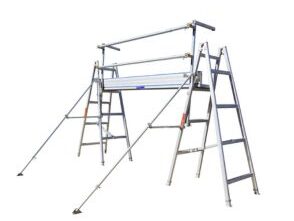
Trestles are a vertical support pair of ladders in the shape of a triangle. Tripods provide vertical support to the trestle platform. Aluminum-made tripods are available in various sizes (1.2 to 4.8 meters) and weight ranges (10 kg to 37 kg, respectively).
2. Platform (Decking)
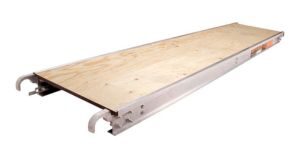
The platform is the primary working surface of the scaffold system. Workers stand on the deck and perform their tasks. The platform is usually wood or metal to ensure strength and durability. The deck should be non-slippery to enhance workers’ safety.
3. Horizontal Beams:
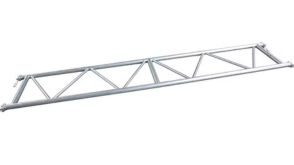
Horizontal beams connect different vertical elements of scaffolds, such as legs or standards, to boost their structural support. These beams distribute load evenly across the scaffold system and maintain the structural integrity of the platform.
4. Braces:

Braces reinforce the scaffolding structure and prevent it from swaying or collapsing. They are typically diagonal components that connect the vertical and horizontal parts, adding strength and stability. Braces help maintain the shape of the scaffold under load and during movement, such as when workers are shifting positions or when exposed to external forces like wind.
5. Guardrails and Toeboards

Guardrails and toes are essential safety features of trestle scaffold systems. Guardrails are safety rails installed around the perimeter of the scaffolding system. These rails protect workers and prevent their accidental fall from the edge. Toeboards are installed at the edge of the scaffolding platform. The purpose of a toeboard is to prevent tools and materials from falling off the scaffold. They are also vital for the protection of people below the scaffold. Toeboards are usually 4 inches high and run across the platform’s edge.
6. Heavy Duty Plank

Trestle heavy-duty planks feature four rubber strips throughout the length to add a solid grip. They are available in different sizes, from 2 meters to 6 meters, and weigh from 7.2 kg to 21.5 kg. The best thing about heavy-duty planks is that they can be customized as per the client’s requirements.
7. Adjustable Legs (Optional)

These days, you can find trestle scaffolds with adjustable legs. These legs let you increase or decrease the height of the scaffold. This feature is helpful as it enables the project to use the same scaffold at varied height levels. Besides, it allows them to adjust the height on uneven surfaces. You can change the legs through a pin and hole or screw mechanism. These adjustable legs are valuable as they let you work safely on varied height surface levels.
8. Trestle Handrail System
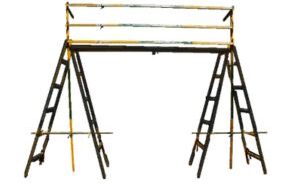
Trestle handrail system consists of an end panel, side/end gate, standard panels, double post brackets, two outriggers, toe board clips and a ladder bracket.Workers needs to work at different heights and risk of falling off is always there. In that scenario, trestle handrails system provide a safe working platform and prevent risk of falling over.
9. Plank Locking Device
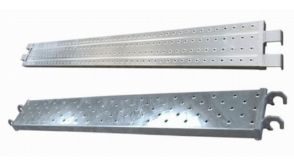
A plank-locking device keeps the multiple planks together in one place. It offers a stable and sturdy platform for the workers. This device is crucial when you position multiple planks together, and there is a risk that one of them may push away. You can eliminate this fall risk by slipping through a plank locking device.
10. Trestle Stays
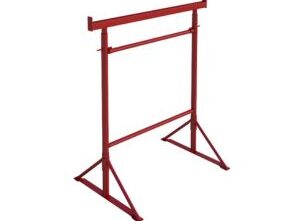
Trestle stays are support parts that stabilize the trestle scaffold system. They are cross-bracing and diagonal supports installed between trestle legs. The purpose of the trestle stay is to avoid lateral movement of the structure and ensure that the trestle stays stable under load. Trestle stays are the most important part of the scaffold system, especially in a high-wind environment, because they prevent the structure from swaying.
What is the Diagram of Trestle Scaffolding?







